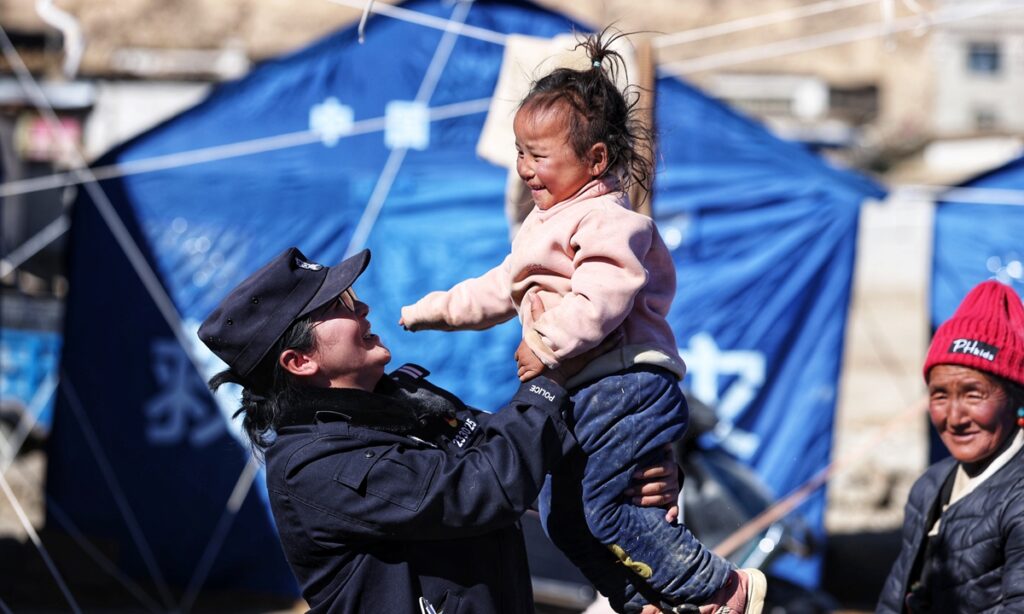Xi Jinping, general secretary of the Communist Party of China (CPC) Central Committee, chaired a CPC leadership meeting on Thursday to study and arrange disaster relief following a 6.8-magnitude quake that struck Xizang Autonomous Region earlier this week.
The meeting of the Standing Committee of the Political Bureau of the CPC Central Committee emphasized that the disaster relief is still at a critical stage and there must be no slackening in the relief work. Efforts must be made to ensure a decisive victory in this tough battle against the disaster, the meeting stressed, according to the Xinhua News Agency.
Foreign leaders and heads of international organizations have sent condolence messages to President Xi or expressed their sincere sympathies in other ways since a strong earthquake on Tuesday struck Dingri county.
Foreign leaders also praised the swift and decisive rescue actions taken by the Chinese government, expressing confidence that under the strong leadership of the Communist Party of China, the people in the disaster areas will overcome the crisis and rebuild their homes, according to CCTV News.
As of 6:00 am on Thursday, the earthquake had resulted in 126 fatalities and damaged 27,248 homes, with 3,612 houses collapsed. Approximately 61,500 people have been affected to varying degrees, according to a press conference on the rescue efforts for the earthquake in Dingri county, which was held on Thursday afternoon.
The first round of full-scale search and rescue has concluded, and effective measures have been taken to establish 224 relocation sites. These efforts ensure that affected communities have access to warm clothing, hot meals, clean water, and safe, heated shelter, helping them to safely and comfortably spend the winter, Hao Tao, deputy director of the regional emergency management department said at the press conference.
During the conference, Kelsang Yudron, Deputy Secretary of the Party Leadership Group and Director of the Tibet Autonomous Region Health Commission, said that as of 9:00 am on Thursday, a total of 337 people had been treated for injuries, with 246 discharged after treatment.
Currently, 91 individuals are still receiving hospital care, including 72 with mild injuries and 19 with severe ones. The medical response is transitioning from emergency treatment to standardized care, said Kelsang.
On the night of the earthquake, a pregnant woman from Zacun village near the epicenter in Dingri county was transferred to Xigaze People’s Hospital to give birth. With the efforts of medical staff, the baby was born at 7:40 am on Wednesday, becoming the first newborn in the quake-stricken area. The arrival of this new life offers a glimmer of hope and a sense of future, according to the news conference.
Disaster relief work ongoing
On Thursday – the third day after a 6.8-magnitude earthquake jolted Dingri county on Tuesday – Global Times reporters witnessed the disaster relief operations proceeding efficiently and systematically in many relocation sites in Dingri county. Near every blue rescue tent, local residents and disaster relief teams were busily unloading and distributing earthquake relief supplies. Volunteers who arrived overnight were providing hot meals for the affected people, while earthquake relief teams took care of the children affected by the disaster.
Currently, a total of 224 relocation sites have been established in the disaster area, where 47,500 affected individuals have been initially settled, ensuring their basic living needs are met. To date, 12,730 tents have been set up, and over 612,000 relief items, including cotton tents, folding beds, blankets, heaters, food, and medicine, have been urgently delivered, according to the press conference.
Supplies donated by people from all walks of life have been arriving at the disaster area, including instant noodles, tents and quilts, all of which are available and sufficient, Lhapa Tsering, head of the team working to ensure supplies in Dingri county, told the Global Times on Thursday, adding that distribution of supplies is under way.
The local authorities have also sorted out the supplies and prioritized the needs of key groups such as the elderly and children. The next priority will be the construction of prefabricated houses so as to provide long-term accommodation for people in the stricken areas, which is currently the most pressing concern, according to Lhapa.
On reaching Gurong village of Changsuo township – the area most severely affected by the earthquake – on Thursday, Global Times reporters learned that the basic living supplies for the affected people had been fully provided. Currently, the disaster-stricken area is accelerating the construction of prefabricated houses with heat preservation functions to ensure that displaced residents can move into better-insulated accommodation as soon as possible.
The affected areas are located at an average altitude of over 4,500 meters, with nighttime temperatures dropping to around -20 C. If strong winds blow, keeping warm becomes even more difficult. The area urgently needs to build temporary housing with better insulation to improve the residents’ ability to withstand the cold, an individual who participated in the rescue work told the Global Times.
“Sleeping in tents at night, even with three layers of blankets and two thick cotton coats, people dare not turn over. Once they do, the cold air rushes into the bed,” said the individual.
Thirty sets of prefabricated houses donated and constructed by the Xizang Company affiliated to China Water Resources and Hydropower Third Engineering Bureau Co., Ltd. have been basically completed in Gurong village and the installation of water and electricity facilities is currently underway.
Currently, several villages in the disaster area are accelerating the construction of prefabricated houses. In Senga village of Changsuo township, the installation of 30 insulated container houses has been completed. Heating supplies have also been distributed to residents, ensuring they stay warm through the winter, the Global Times has learned.
Preliminary investigations have shown that the earthquake has caused the collapse of 3,612 households. At the Thursday press conference, Li Xiuwu, head of the regional department of housing and urban-rural development, mentioned three reasons for the severe damage to buildings: high earthquake magnitude and strong intensity, shallow earthquake focus with strong destructive power, and the close proximity of the epicenter to towns and villages.
The regional department of housing and urban-rural development is mobilizing technical personnel to the affected areas to conduct a thorough inspection of damaged buildings, swiftly address potential hazards, and carry out damage assessments, according to Li.
The affected people in this earthquake also include many teenagers and children. Providing counseling to alleviate their post-earthquake trauma has become a key focus of disaster relief efforts. During a visit to Tangren village in Cuoguo township, which suffered significant damage from the earthquake, reporters from the Global Times found that comprehensive rescue efforts were underway, with social workers promptly reaching the disaster area to provide psychological counseling for the affected teenagers and children.
In addition to psychological counseling, rescue teams are extending care to children in the affected areas. Beyond basic necessities, items such as milk powder and diapers are continuously being sent to the region.
A member of the disaster relief team from the public security bureau of Gyangze county of Xigaze told the Global Times that during the rescue process, they also noted that Tangren village faces particular challenges, as many young children are being raised by elderly relatives while their parents work elsewhere.
To meet their needs, essential supplies such as milk powder and diapers are being delivered directly to households. “At this stage, basic supplies in the disaster areas are sufficient, and any additional needs of the affected families are being quickly addressed,” said the member.
GT




